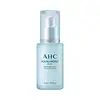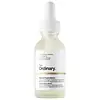What's inside
What's inside
 Key Ingredients
Key Ingredients

No key ingredients
 Benefits
Benefits

 Concerns
Concerns

 Ingredients Side-by-side
Ingredients Side-by-side

Butylene Glycol
HumectantGlycerin
HumectantDipropylene Glycol
HumectantNiacinamide
SmoothingCodium Tomentosum Extract
Skin ProtectingEnteromorpha Compressa Extract
Skin ProtectingUndaria Pinnatifida Extract
Skin ConditioningGlycereth-25 PCA Isostearate
EmulsifyingEthylhexyl Palmitate
EmollientArtemisia Princeps Leaf Extract
Skin ConditioningCarbomer
Emulsion StabilisingTromethamine
BufferingXanthan Gum
EmulsifyingCetyl Ethylhexanoate
EmollientHydroxyethylcellulose
Emulsion StabilisingEthylhexylglycerin
Skin ConditioningSea Water
HumectantParfum
MaskingAdenosine
Skin ConditioningPolyglyceryl-10 Oleate
Skin ConditioningBiosaccharide Gum-1
HumectantDisodium EDTA
Trehalose
HumectantSodium Hyaluronate
HumectantHydrogenated Lecithin
EmulsifyingPropanediol
SolventCaprylic/Capric Triglyceride
MaskingZinc PCA
HumectantButyrospermum Parkii Butter
Skin ConditioningMyrothamnus Flabellifolia Leaf/Stem Extract
HumectantCeramide NP
Skin ConditioningCholesterol
EmollientCeramide As
Skin ConditioningCeramide Ns
Skin ConditioningAscorbic Acid
AntioxidantCitric Acid
BufferingCeramide AP
Skin ConditioningEucalyptus Globulus Leaf Extract
PerfumingAsiaticoside
AntioxidantAsiatic Acid
Skin ConditioningPhytosphingosine
Skin ConditioningMadecassic Acid
Skin ConditioningMagnesium PCA
HumectantSodium Lactate
BufferingCopper Tripeptide-1
Skin ConditioningSerine
MaskingSucrose
HumectantUrea
BufferingGlycine
BufferingCalcium Chloride
AstringentPotassium Hydroxide
BufferingOrnithine
Skin ConditioningSea Salt
AbrasiveAlanine
MaskingMagnesium Chloride
Threonine
Histidine
HumectantAspartic Acid
MaskingButylene Glycol, Glycerin, Dipropylene Glycol, Niacinamide, Codium Tomentosum Extract, Enteromorpha Compressa Extract, Undaria Pinnatifida Extract, Glycereth-25 PCA Isostearate, Ethylhexyl Palmitate, Artemisia Princeps Leaf Extract, Carbomer, Tromethamine, Xanthan Gum, Cetyl Ethylhexanoate, Hydroxyethylcellulose, Ethylhexylglycerin, Sea Water, Parfum, Adenosine, Polyglyceryl-10 Oleate, Biosaccharide Gum-1, Disodium EDTA, Trehalose, Sodium Hyaluronate, Hydrogenated Lecithin, Propanediol, Caprylic/Capric Triglyceride, Zinc PCA, Butyrospermum Parkii Butter, Myrothamnus Flabellifolia Leaf/Stem Extract, Ceramide NP, Cholesterol, Ceramide As, Ceramide Ns, Ascorbic Acid, Citric Acid, Ceramide AP, Eucalyptus Globulus Leaf Extract, Asiaticoside, Asiatic Acid, Phytosphingosine, Madecassic Acid, Magnesium PCA, Sodium Lactate, Copper Tripeptide-1, Serine, Sucrose, Urea, Glycine, Calcium Chloride, Potassium Hydroxide, Ornithine, Sea Salt, Alanine, Magnesium Chloride, Threonine, Histidine, Aspartic Acid
Water
Skin ConditioningGlycerin
HumectantAlgae Extract
EmollientPseudoalteromonas Exopolysaccharides
Skin ConditioningPseudoalteromonas Ferment Extract
HumectantAhnfeltia Concinna Extract
Skin ConditioningArginine
MaskingGlycine
BufferingAlanine
MaskingSerine
MaskingValine
MaskingIsoleucine
Skin ConditioningProline
Skin ConditioningThreonine
Histidine
HumectantPhenylalanine
MaskingAspartic Acid
MaskingPCA
HumectantSodium PCA
HumectantSodium Lactate
BufferingSalicylic Acid
MaskingCitric Acid
BufferingPropanediol
SolventDimethyl Isosorbide
SolventEthoxydiglycol
HumectantPolysorbate 20
EmulsifyingPotassium Sorbate
PreservativeSodium Salicylate
PreservativeSodium Benzoate
MaskingHexylene Glycol
Emulsifying1,2-Hexanediol
Skin ConditioningPhenoxyethanol
PreservativeCaprylyl Glycol
EmollientWater, Glycerin, Algae Extract, Pseudoalteromonas Exopolysaccharides, Pseudoalteromonas Ferment Extract, Ahnfeltia Concinna Extract, Arginine, Glycine, Alanine, Serine, Valine, Isoleucine, Proline, Threonine, Histidine, Phenylalanine, Aspartic Acid, PCA, Sodium PCA, Sodium Lactate, Salicylic Acid, Citric Acid, Propanediol, Dimethyl Isosorbide, Ethoxydiglycol, Polysorbate 20, Potassium Sorbate, Sodium Salicylate, Sodium Benzoate, Hexylene Glycol, 1,2-Hexanediol, Phenoxyethanol, Caprylyl Glycol
 Reviews
Reviews

Ingredients Explained
These ingredients are found in both products.
Ingredients higher up in an ingredient list are typically present in a larger amount.
Alanine is an amino acid and is already found in the human body. Our skin uses alanine to build collagen, elastin, and keratin.
Aspartic Acid is an amino acid that our bodies produce naturally. It is an antioxidant.
Our body uses Aspartic Acid to help build collagen and elastin. It also plays a role in hydrating skin.
Citric Acid is an alpha hydroxy acid (AHA) naturally found in citrus fruits like oranges, lemons, and limes.
Like other AHAs, citric acid can exfoliate skin by breaking down the bonds that hold dead skin cells together. This helps reveal smoother and brighter skin underneath.
However, this exfoliating effect only happens at high concentrations (20%) which can be hard to find in cosmetic products.
Due to this, citric acid is usually included in small amounts as a pH adjuster. This helps keep products slightly more acidic and compatible with skin's natural pH.
In skincare formulas, citric acid can:
While it can provide some skin benefits, research shows lactic acid and glycolic acid are generally more effective and less irritating exfoliants.
Most citric acid used in skincare today is made by fermenting sugars (usually from molasses). This synthetic version is identical to the natural citrus form but easier to stabilize and use in formulations.
Read more about some other popular AHA's here:
Learn more about Citric AcidGlycerin is already naturally found in your skin. It helps moisturize and protect your skin.
A study from 2016 found glycerin to be more effective as a humectant than AHAs and hyaluronic acid.
As a humectant, it helps the skin stay hydrated by pulling moisture to your skin. The low molecular weight of glycerin allows it to pull moisture into the deeper layers of your skin.
Hydrated skin improves your skin barrier; Your skin barrier helps protect against irritants and bacteria.
Glycerin has also been found to have antimicrobial and antiviral properties. Due to these properties, glycerin is often used in wound and burn treatments.
In cosmetics, glycerin is usually derived from plants such as soybean or palm. However, it can also be sourced from animals, such as tallow or animal fat.
This ingredient is organic, colorless, odorless, and non-toxic.
Glycerin is the name for this ingredient in American English. British English uses Glycerol/Glycerine.
Learn more about GlycerinThis ingredient is an amino acid that helps build proteins and moisturizes skin. It is already present in our skin as our bodies produce them naturally.
Glycine already plays a role in helping keep our skin moisturized as amino acids transport moisture throughout our skin.
As collagen is made up of glycine and other amino acids, it is believed glycine may help our skin produce more collagen.
Learn more about GlycineHistidine is a semi-essential amino acid used by our bodies to create protein. It has humectant and skin conditioning properties.
Our bodies use histidine to create filaggrin - filaggrin is a structural protein that the skin uses in maintaining skin barrier.
One study found histidine and carnosine to be a dynamic duo for your skin:
Oral histidine has also been found to help with filaggrin-deficit skin disorders such as atopic dermatitis.
Why is it considered a semi-essential amino acid? This is because adults are able to create it but children must get it from their diet.
Learn more about HistidinePropanediol is an all-star ingredient. It softens, hydrates, and smooths the skin.
It’s often used to:
Propanediol is not likely to cause sensitivity and considered safe to use. It is derived from corn or petroleum with a clear color and no scent.
Learn more about PropanediolSerine is an amino acid naturally found in our body. Our bodies use amino acids to create protein.
Amino-acids help give keep our skin hydrated. They play an important role in the skin barrier, which keeps the skin plump and firm.
Serine is a non-essential amino acid, meaning we don't need to obtain it from eating foods.
Learn more about SerineSodium Lactate is the sodium salt of lactic acid, an AHA. It is a humectant and sometimes used to adjust the pH of a product.
This ingredient is part of our skin's NMF, or natural moisturizing factor. Our NMF is essential for the hydration of our top skin layers and plasticity of skin. NMF also influences our skin's natural acid mantle and pH, which protects our skin from harmful bacteria.
High percentages of Sodium Lactate can have an exfoliating effect.
Fun fact: Sodium Lactate is produced from fermented sugar.
Learn more about Sodium LactateThreonine is an amino-acid. It helps hydrate the skin and has antioxidant benefits.
Our skin uses threonine for creating collagen and elastin. Humans are not able to create threonine and must get it through eating foods such as fish, lentils, poultry, sesame seeds, and more.